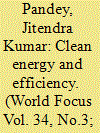|
|
|
Sort Order |
|
|
|
Items / Page
|
|
|
|
|
|
|
| Srl | Item |
| 1 |
ID:
118109


|
|
|
| 2 |
ID:
103374


|
|
|
|
|
| Publication |
2011.
|
| Summary/Abstract |
Climate change, pollution, and energy insecurity are among the greatest problems of our time. Addressing them requires major changes in our energy infrastructure. Here, we analyze the feasibility of providing worldwide energy for all purposes (electric power, transportation, heating/cooling, etc.) from wind, water, and sunlight (WWS). In Part I, we discuss WWS energy system characteristics, current and future energy demand, availability of WWS resources, numbers of WWS devices, and area and material requirements. In Part II, we address variability, economics, and policy of WWS energy. We estimate that 3,800,000 5 MW wind turbines, 49,000 300 MW concentrated solar plants, 40,000 300 MW solar PV power plants, 1.7 billion 3 kW rooftop PV systems, 5350 100 MW geothermal power plants, 270 new 1300 MW hydroelectric power plants, 720,000 0.75 MW wave devices, and 490,000 1 MW tidal turbines can power a 2030 WWS world that uses electricity and electrolytic hydrogen for all purposes. Such a WWS infrastructure reduces world power demand by 30% and requires only 0.41% and 0.59% more of the world's land for footprint and spacing, respectively. We suggest producing all new energy with WWS by 2030 and replacing the pre-existing energy by 2050. Barriers to the plan are primarily social and political, not technological or economic. The energy cost in a WWS world should be similar to that today.
|
|
|
|
|
|
|
|
|
|
|
|
|
|
|
|
| 3 |
ID:
103375


|
|
|
|
|
| Publication |
2011.
|
| Summary/Abstract |
This is Part II of two papers evaluating the feasibility of providing all energy for all purposes (electric power, transportation, and heating/cooling), everywhere in the world, from wind, water, and the sun (WWS). In Part I, we described the prominent renewable energy plans that have been proposed and discussed the characteristics of WWS energy systems, the global demand for and availability of WWS energy, quantities and areas required for WWS infrastructure, and supplies of critical materials. Here, we discuss methods of addressing the variability of WWS energy to ensure that power supply reliably matches demand (including interconnecting geographically dispersed resources, using hydroelectricity, using demand-response management, storing electric power on site, over-sizing peak generation capacity and producing hydrogen with the excess, storing electric power in vehicle batteries, and forecasting weather to project energy supplies), the economics of WWS generation and transmission, the economics of WWS use in transportation, and policy measures needed to enhance the viability of a WWS system. We find that the cost of energy in a 100% WWS will be similar to the cost today. We conclude that barriers to a 100% conversion to WWS power worldwide are primarily social and political, not technological or even economic.
|
|
|
|
|
|
|
|
|
|
|
|
|
|
|
|
|
|
|
|
|